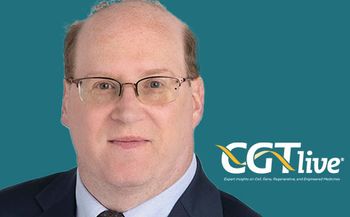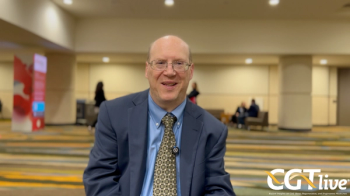
Tarlatamab Bispecific T-Cell Engager Yields Responses in Small Cell Lung Cancer
ORR was 40% in the 10-mg group and 32% in the 100-mg group.
Patients with previously treated small-cell lung cancer (SCLC) treated with 10 mg tarlatamab
"Small cell lung cancer has represented one of the greatest challenges in cancer treatment, where there has been little progress against this deadly tumor type in decades," David M. Reese, MD, executive vice president, Research and Development, Amgen, said in a statement.2 "The tarlatamab results show the potential for this BiTE molecule in a common solid tumor. We look forward to discussing these potentially registrational data with regulatory authorities."
Tarlatamab is a BiTE immunotherapy targeting delta-like ligand 3 and CD3. Investigators, including first author Myung-Ju Ahn, MD, PhD, Professor, hemato-oncology, Department of Medicine, Sungkyunkwan University School of Medicine, Seoul, evaluated 10 and 100 mg doses of tarlatamab every 2 weeks in 220 patients in the phase 2 trial.1
The trial’s primary end points were ORR, adverse events (AEs), and serum concentrations of tarlatamab. Secondary end points include duration of response (DoR), disease control, duration of disease control, progression-free survival (PFS), overall survival, and anti-tarlatamab antibody formation. Patients in the trial previously received a median of 2 lines of treatment. Part 1 was a dose-comparison assessment in approximately 180 patients; part 2 enrolled 100 patients at the 10-mg dose, and part 3 was a substudy evaluating the safety of tarlatamab with reduced inpatient monitoring during cycle 1.
WATCH NOW:
In all three parts, patients received a step dose of 1 mg of tarlatamab on day 1 of cycle 1, then either 10 mg or 100 mg on day 8 and day 15 of cycle 1, and then every 2 weeks after in 28-day cycles until disease progression occurred. Patients received an 8-mg dose of dexamethasone on days 1 and 8 of cycle 1. Safety follow-up occurred 6 weeks after the last dose of tarlatamab, and then every 3 months for 1 year or every 3 months for 5 years after the first patient was enrolled.
Among evaluable patients, the median follow-up was 10.6 months in the 10-mg group and 10.3 months in the 100-mg group. ORR was 40% (97.5% CI [29-52) in the 10-mg group and 32% (97.5% CI, 21-44) in the 100-mg group. DoR was at least 6 months in 59% (n = 40) of patients, with responses ongoing in 55% (n = 22) of the 10-mg group and 57% (n = 16) in the 100-mg group. The median PFS was 4.9 months (95% CI, 2.9 to 6.7) in the 10-mg group and 3.9 months (95% CI, 2.6 to 4.4) in the 100-mg group. Kaplan-Meier estimates of survival were 68% and 66% of patients at 9 months, respectively.1
The most common AEs were cytokine-release syndrome (CRS; 51%,10-mg; 61%, 100-mg), decreased appetite (29%, 10-mg; 44%, 100-mg), and pyrexia (35%, 10-mg; 33%, 100-mg). CRS occurred primarily during treatment cycle 1 and was mostly grades 1 and 2. Grade 3 CRS occurred in 1% of patients in the 10-mg group and 6% of the 100-mg group. Neutropenia was observed at a 17% rate in the 10-mg group and at a 16% rate in the 100-mg group AEs caused 3% of patients to discontinue tarlatamab. Around half of patients were alive at the last follow-up visit (57%, 10-mg; 51%, 100-mg) and OS data are not yet mature.1
Patient-reported outcomes were also positive, with positive trends of improvement in global health status and symptoms of lung cancer from baseline. Antitarlatamab binding antibodies developed during the treatment period in 3% (n = 4) of the 10-mg group and 4% (n = 3) in the 100-mg group.1
"In the current third-line treatment of SCLC, patients face a dire prognosis, with response rates ranging between 14 and 21 percent and median overall survival less than six months," Luis Paz-Ares, MD, PhD, chairman, Medical Oncology Department, Hospital Doce de Octubre and Head, Lung Cancer Unit, National Oncology Research Center (CNIO), and associate professor, Universidad Complutense, added.2
REFERENCES
1. Ahn MJ, Cho BC, Felip E, et al. Tarlatamab for patients with previously treated small-cell lung cancer. N Engl J Med 2023; 389:2063-2075. doi: 10.1056/NEJMoa2307980
2. Amgen presents new tarlatamab data in small cell lung cancer. News release. Amgen. October 20, 2023. https://www.prnewswire.com/news-releases/amgen-presents-new-tarlatamab-data-in-small-cell-lung-cancer-301963139.html
Newsletter
Stay at the forefront of cutting-edge science with CGT—your direct line to expert insights, breakthrough data, and real-time coverage of the latest advancements in cell and gene therapy.

















































